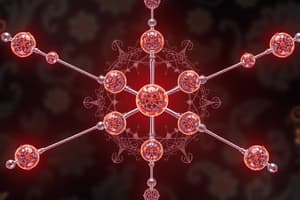Podcast
Questions and Answers
What is the purpose of Lewis structures?
What is the purpose of Lewis structures?
- To determine the reactivity of compounds
- To calculate the melting and boiling points of compounds
- To predict the shape of molecules
- To illustrate the distribution of electrons within molecules or ions (correct)
What type of bonds are represented by shared pairs of electrons in Lewis structures?
What type of bonds are represented by shared pairs of electrons in Lewis structures?
- Metallic bonds
- Covalent bonds (correct)
- Ionic bonds
- Hydrogen bonds
What is the Octet Rule?
What is the Octet Rule?
- Main group elements tend to form enough bonds to obtain ten electrons in their valence shell
- Main group elements tend to form enough bonds to obtain four electrons in their valence shell
- Main group elements tend to form enough bonds to obtain six electrons in their valence shell
- Main group elements tend to form enough bonds to obtain eight electrons in their valence shell (correct)
What type of ion is formed when a sodium atom loses one electron?
What type of ion is formed when a sodium atom loses one electron?
What type of ion is formed when a chlorine atom gains one electron?
What type of ion is formed when a chlorine atom gains one electron?
How are the Lewis structures of ionic compounds depicted?
How are the Lewis structures of ionic compounds depicted?
What is the first step to draw Lewis structures for ionic compounds?
What is the first step to draw Lewis structures for ionic compounds?
In an ionic compound, which element is typically placed in the center when drawing Lewis structures?
In an ionic compound, which element is typically placed in the center when drawing Lewis structures?
How do atoms achieve full octets in ionic compounds?
How do atoms achieve full octets in ionic compounds?
What happens to the excess electrons in an ionic compound when drawing its Lewis structure?
What happens to the excess electrons in an ionic compound when drawing its Lewis structure?
Which atom in an ionic compound would most likely lose electrons to become a cation?
Which atom in an ionic compound would most likely lose electrons to become a cation?
In the formation of an ionic compound, which process helps us visualize the arrangement of atoms and the distribution of electrons?
In the formation of an ionic compound, which process helps us visualize the arrangement of atoms and the distribution of electrons?
Flashcards are hidden until you start studying
Study Notes
Lewis Structures of Ions
Introduction
Lewis structures, also known as Lewis diagrams, are graphical representations of the bonding in organic compounds. They were developed by Gilbert Lewis in the early 20th century. These structures are used to understand electron distribution within molecules or ions, which is crucial for predicting their chemical behavior. This article will focus on understanding the Lewis structures of ions.
Depicting Ions with Lewis Structures
Ionic compounds consist of oppositely charged species held together by electrostatic forces. The formation of these ions can be visualized using Lewis symbols, which illustrate the transfer of electrons between atoms. For example, sodium atoms lose one electron to form Na+ cations, while chlorine atoms gain one electron to form Cl− anions.
In molecular compounds, shared pairs of electrons represent covalent bonds. When two chlorine atoms share one pair of electrons, they each have eight valence electrons, fulfilling the octet rule. The Octet Rule states that main group elements tend to form enough bonds to obtain eight electrons in their valence shell, achieving noble gas electron configurations.
Example: Potassium Sulfide (K2S)
The formation of potassium sulfide (K2S) involves the combination of potassium (K) atoms, which require two electrons to complete their octets, and sulfur (S) atoms, which need only one more electron for their octets. Two sulfur atoms accept the two electrons from one potassium atom, leading to the final ionic compound (K2S) with all atoms having full octets.
Drawing Lewis Structures for Ionic Compounds
To draw Lewis structures for ionic compounds, follow these steps:
-
Arrange Atoms Around Central Atom: Place the least electronegative element in the center, usually a metal, and surround it with other atoms (typically nonmetals).
-
Connect Each Atom to the Central Atom: Use single bonds to connect each atom to the central atom.
-
Place Excess Electrons as Lone Pairs: Distribute any remaining electrons as lone pairs on the terminal atoms, except for hydrogen, completing an octet around each atom.
-
Place All Remaining Electrons on the Central Atom: If necessary, place all remaining electrons on the central atom to achieve a neutral charge.
Example: Magnesium Chloride (MgCl2)
In magnesium chloride (MgCl2), a magnesium atom loses its two outermost electrons, forming a divalent cation (Mg2+). Two chlorine atoms each gain one electron, creating monovalent anions (Cl−). The structure shows two magnesium atoms bonded to four chlorine atoms.
Example: Calcium Chloride (CaCl2)
Calcium chloride (CaCl2) involves a calcium atom losing two electrons to become Ca2+, while two chlorine atoms gain one electron each to become Cl−. The structure consists of one central calcium atom bonded to four chlorine atoms.
Summary
In summary, Lewis structures play a vital role in understanding the electronic configurations of molecules or ions, particularly when predicting chemical behavior. By following a systematic process of arranging atoms around a central element and distributing electrons based on the octet rule, we can visualize the formation of ionic compounds and gain insights into their properties.
Studying That Suits You
Use AI to generate personalized quizzes and flashcards to suit your learning preferences.




